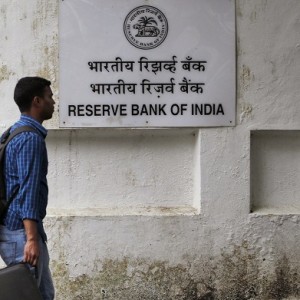
An Indian man walks outside the headquarters of the Reserve Bank of India in Mumbai, India, Tuesday, July 30, 2013. The RBI kept all key interest rates unchanged Tuesday and asked the government to take urgent steps to cut down growth and boost investments. AP Photo/Rajanish Kakade
MUMBAI—India’s central bank kept benchmark interest rates unchanged Tuesday as part of its struggle to prop up the battered rupee but the currency weakened further to hover just above a lifetime low.
Deciding against a rate cut, the Reserve Bank of India (RBI) made it clear its key priority right now is to support the rupee at the expense of spurring an economy that has been expanding at its weakest level in a decade.
India has been forced to “address external sector concerns,” the bank said, as it announced it would keep its main lending rate to commercial banks—the repo—unchanged at 7.25 percent.
The RBI cut its forecast for economic growth for the current financial year to 5.5 percent from an earlier projection of 5.7 percent.
But in the absence of any fresh monetary tightening steps, the currency slid to 60.40 rupees to the dollar, close to its record low of 61.21 rupees hit earlier this month.
“The RBI has done everything to defend the rupee—but it did not hike rates,” Param Sarma, chief executive at NSP Forex, told AFP.
Business leaders and Finance Minister P. Chidambaram have been pushing for cheaper borrowing rates to boost growth, but even industry seemed resigned Tuesday to the bank’s decision to leave rates on hold with the rupee under pressure.
“We understand the decision of the RBI on the rates,” said Confederation of Indian Industry president Kris Gopalakrishnan.
Worried
The bank is worried about the currency weakening further as it would push up the cost of imports, drive up already stubbornly high consumer price inflation and risk a widening of the current account deficit, which hit a record 4.8 percent of gross domestic product last year.
The gaping current account, the broadest measure of trade, has been one of the key factors putting pressure on the rupee.
Earlier this month, the central bank raised two short-term lending rates to support the rupee, which is the worst-performing currency among major Asian nations.
Central bank governor Duvvuri Subbarao promised the tightening “will be rolled back in a calibrated manner as stability is restored to the foreign exchange market, enabling monetary policy to revert to supporting growth”.
But HSBC’s chief India economist Leif Eskesen said he did not expect any easing of interest rates for at least three months.
The RBI had kept rates unchanged when it last met in June—after three successive rate cuts—citing concerns about the soft rupee and inflation.
Raghuram Rajan, chief economic adviser to the finance ministry, said the government would in coming weeks outline “specific steps” to contain the current account deficit, which has alarmed global ratings agencies.
“The RBI and the government are on the same page and working together to achieve stability and growth,” said Rajan, seen as a possible successor to the bank governor whose term ends in September.
India’s economic woes have led to increased speculation that it could be headed for an economic crisis of the sort it suffered in 1991, which forced a bailout by the International Monetary Fund.
The rupee weakness is the latest blow for the scandal-tainted Congress-led coalition of Premier Manmohan Singh, which is keen to see the economy revive before facing voters in polls due in the first half of 2014.
In comments in The Indian Express on Tuesday, veteran economist Arvind Panagariya warned of India’s dependence on foreign capital and said its foreign exchange reserves were too low.
Panagariya, a former chief economist of the Asian Development Bank, said he had been optimistic India would weather its difficulties “but today I am a little worried.”
“I feel shaky. Now there is a 10-20 percent chance that we might see 1991 again,” he said.—Salil Panchal